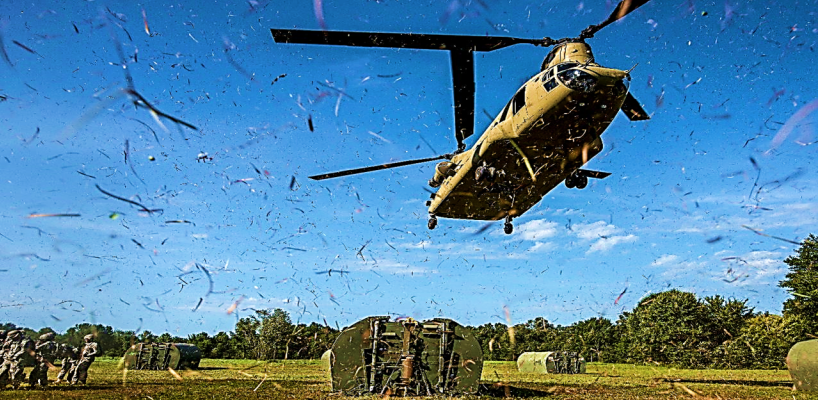A House Appropriations Committee leak to Anthony Capaccio and Roxana Tiron at Bloomberg has revealed a congressional directive that is sure to be giving Secretary of the Army Dr. Mark Esper some heartburn. According to the pair’s report published Friday afternoon, the committee is not pleased with Esper’s plan to stop buying Boeing’s CH-47F Block II helicopter after Boeing fulfills the current purchase order.
Each year, Congress does its part to shape military spending, especially procurement, by directing increased or decreased spending on individual procurement programs. These can be minor adjustments, curtailments due to what Congress sees as unjustified requests for increases, or, in some cases, direction to buy things the military doesn’t want.
This would be one of those times.
PEG Deep Dives were supposed to free money for new priorities
The committee’s defense subcommittee met last Wednesday to mark-up the draft Defense Appropriations Act for Fiscal Year 2020. The draft bill that came out of that session is missing a key piece: the “finding tables” that “adjust” the Pentagon’s request at the program level. Those tables are part of the committee report that will come after the full committee marks-up the bill Monday.
For the past year, the Army’s senior leadership have been conducting what has come to be called “night court” sessions within each of the Army’s Program Evaluation Groups. The six PEGs align with the Army’s Title 10 responsibilities: Organizing (OO PEG), Manning (MM PEG), Equipping (EE PEG), Sustaining (SS PEG), Training (TT PEG), and Installations (II PEG).
In the night court sessions, PEG chairs have had to justify each program and demonstrate its relevance to one of the Army’s two main objectives: restore readiness and modernize for the future. All told, 93 programs were “zeroed out” (meaning they’re not formally canceled, they’re just not getting any more money, a subtle difference), and another 93 were scaled back. This gave the Army $31 billion over the next five years to redirect to its six modernization priorities. Or so it hoped.
Bloomberg’s scoop represents the first evidence of Congressional push-back on the Army’s big plans.
A good helicopter, but an old one
The CH-47, known as the Chinook, is a true workhorse. It flies higher, farther, and faster than any other helicopter in the Army’s inventory, and can carry a useful load of 25,000 pounds. But it’s been around for a long time. It evolved in the late 1950s from the Vertol Model 107. Production on the first Chinooks began in 1962. The CH-47F Block II variant is designed to replace the CH-47D variants which first entered service in 1982.
The Army’s budget justification documents still say that will be the Army’s main heavy lift aircraft “for the sext several decades.” Esper wants industry to help him accelerate its replacement.
The Block II program was designed to “insert critical and affordable technologies into the Chinook fleet” to keep up with the latest requirements. Last year, the Army requested $123.5 million to purchase six Chinooks, and planned to buy eight in Fiscal Year 2020, 13 in both FY 2021 (when the first block Its will come off the assembly line) and FY 2022, and 17 in FY 2023.
When the president sent his budget request to Congress in March, the Army maintained its FY 2020 request, but reduced the planned future purchases from 43 to 25. It planned to apply those savings to its Future Vertical Lift program managed by the new Army Futures Command. In late April, Esper told reporters that he wanted industry to be “thinking about future heavy vertical lift, not about how do we maintain what we have now and make upgrades here or there.”
Congress doesn’t like it when you mess with manufacturing jobs
The Army last learned how much Congress likes manufacturing jobs in 2012. Then, it was the General Dynamics-run tank plant in Lima, Ohio plant that the Army wanted to close for a few years. Instead, Congress leapt to the defense of the plant’s workers by adding $183 million to the Army’s FY 2013 budget to keep the plant operating.
Similarly, fears that Boeing would not be able to keep operating its factory in Ridley Park, Penn., next to Philadelphia’s airport, are driving Congressional action. The Chinook, and Boeing, have a powerful and bipartisan group of supporters, including Rep. Adam Smith, chairman of the House Armed Services Committee. While Boeing’s corporate headquarters is in Chicago, its largest manufacturing facility is just north of Seattle, Wash. Smith’s district is just south of Seattle, and includes the King County International Airport, also known as Boeing Field, where the company still tests many of its planes.
So add the Chinook to the list of sticking points between the administration and the Democrats in the House of Representatives over the future of military spending. It’s going to be a long summer and a longer autumn before we have a final budget.



